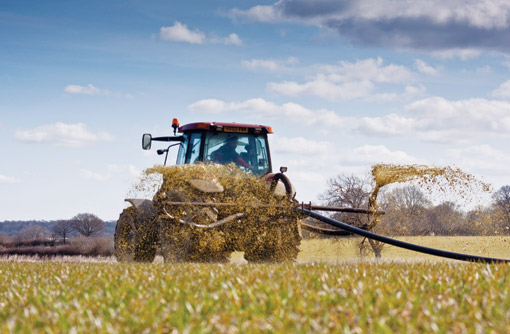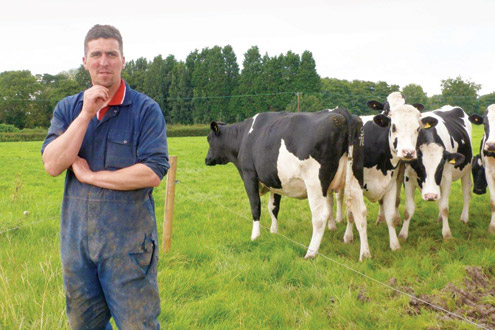How adding inoculant to slurry can reduce fertiliser bills

Exploiting the nutrient value of slurry by using an inoculant has the potential to make substantial savings against a farm’s annual fertiliser bill.
Research by Lancaster University is exploring the potential of bio-technology that could enable applications of treated slurry to “unlock” additional nutrient reserves from the soil.
Phosphorus is essential to enable plants to store and transfer energy, but it also has a host of other roles including root development and seed production, says Envirosystems managing director Liz Russell, who has been involved with the research.
“Supplies of phosphorus are dwindling so this research will focus on whether farmers can secure their own phosphorus needs by treating slurry with an inoculant and will look at the knock-on benefits to soil structure – something we need to become more aware of as land is expected to cope with extremes of climate.”
The Lancaster University research will investigate the interaction between plant roots and the phosphorus compounds that occur in soil.
It will consider if there are ways in which organic phosphorus compounds in soil can be made more available to plant roots, rather than solely relying on the application of inorganic phosphorus to support production.
Trial results
On-farm trials have already shown that following five weeks of treatment with an inoculant, treated slurry contained three times more nitrogen when compared with untreated samples.
Treated slurry showed nitrogen levels at 5.6kg/cu m compared with untreated slurry at 1.7kg/cu m.
“In the treated slurry the ammonium nitrogen appeared to be used up by the SlurryBugs inoculant and was transformed into organic forms of nitrogen,” says researcher Maria-Fernanda Aller, who believes the increased retention of nitrogen could explain the reduction in ammonia emissions (odour) following treatment.
Further investigations showed slurry treated with a biological inoculant contained double the phosphorous (P) concentration compared with untreated slurry.
Analysis after five weeks showed the total phosphorus content of the treated slurry at 1.23kg/cu m compared with the untreated slurry at 0.54kg/cu m.
Comments Dr Aller: “The higher phosphorous content could contribute towards more palatable, sweeter grass and better quality silage. The higher N content has a positive effect on organic N when applied to soils.”
Case study one – Lodge Farm
When slurry was analysed last year at Myerscough College’s Lodge Farm in Lancashire it was found to be anaerobic and with a very low dry matter.
It had a pH of 6.95 – lower than seven, so slightly acidic – and a dry matter of 1.05%.
The two most important aspects of a slurry analysis are the pH and the dry matter.
The aim was to improve the nutrient value of this very liquid slurry and to achieve a pH of more than 7 to encourage aerobic activity.
Because of the low level of dry matter this slurry contained 1.6 units of N per fresh tonne of slurry – so that means 7.27 units on N per 1,000gal of slurry applied on the basis of 21.5 units of N per 3,000gal applied, explains Ms Russell.
Following 12-months of treatment, the slurry was analysed again. The pH had increased to 7.93 – creating an alkaline slurry because of the activity of anaerobic bacteria, and the solids had increased to 6.98% dry matter.
“So every tanker load of slurry being applied has a higher nutrient value and is providing four units of N for every fresh tonne of slurry – that’s 18.18 units for every 1,000gal, which is equivalent to a three-fold improvement over untreated slurry.
“On an acreage basis it means for every 3,000gal of treated slurry applied the land is getting 54 units of N for every acre compared with 21 units if the slurry had been left untreated.”
Case study two – Stuart Shepherd
Lancashire dairy farmer Stuart Shepherd has been treating slurry for seven years and has reduced fertiliser costs by 20%.

He is now producing 8.6 units of N from every tonne of inoculated slurry applied to his land at Moons Farm, near Garstang – that equates to 39.10 units of N for every 1,000gal or 95 units of N for every acre.
Samples taken prior to spreading this spring showed the treated slurry was alkaline at pH 7.59 – rather than an acid – and had an impressive dry matter of 12.3%.
Despite the high dry matter the slurry was still “spreadable”, says Mr Shepherd.
However, even though slurry treating in considered to be a winter job, Mr Shepherd stresses the importance of doing it in the summer when bacterial activity in the store benefits from rising temperatures.
Mr Shepherd says the treated slurry achieves longer term benefits to soil quality and nutrient availability and says he’s also saving on liming costs because the slurry makes sure the land is maintained at a pH of 6,” says Mr Shepherd, who milks 180 cows.
